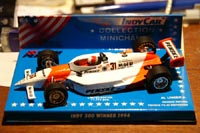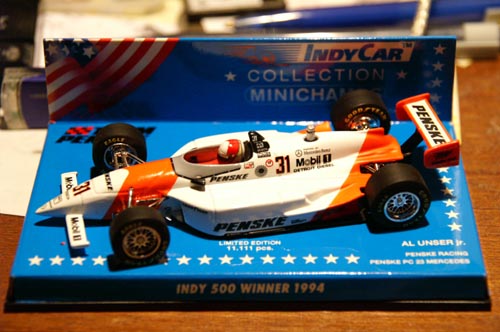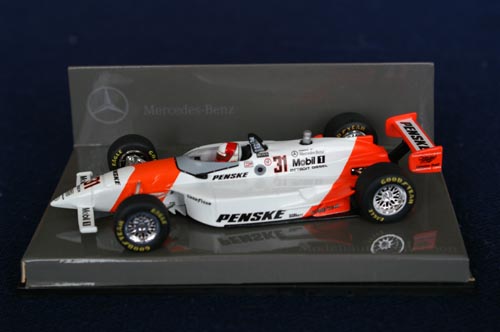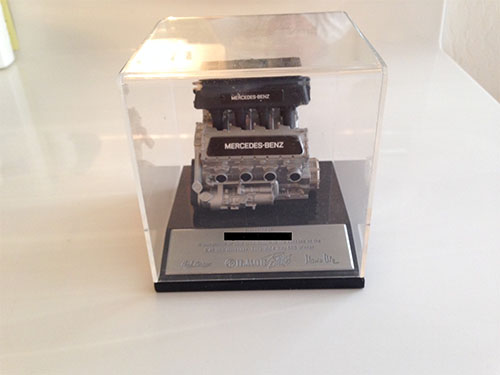Mercedosaurus Rex at Indianapolic Park
Part 17: Creating an extinct species without it being forbidden, initially at least
Author
- Henri Greuter
Date
- December 4, 2009
Related articles
- March-Alfa Romeo 90CA - Fiasco Italo-Brittanico, by Henri Greuter
- March-Porsche 90P - The last oddball at the Indianapolis Motor Speedway, by Henri Greuter
- Penske-Mercedes PC23-500I - Mercedosaurus Rex at Indianapolic Park, by Henri Greuter
- Introduction
- Part 1: Penske Racing at Indianapolis - new standards
- Part 2: Ilmor Engineering at Indianapolis
- Part 3: Mercedes, Benz and Mercedes-Benz at Indianapolis up until 1993
- Part 4: Equivalency formulas - waiting for things to go wrong
- Part 5: Stock blocks - keeping them rolling and promoting 'Born in the USA' technology
- Part 6: Indianapolis 1991 - Chevy And Rich Team owners
- Part 7: The Speedway narrowed, its speeds lowered
- Part 8: The forerunner
- Part 9: Pre-May '94 plans
- Part 10: Penske PC23 - a home for the engine
- Part 11: The 1994 Indycar season until mid-April
- Part 12: The unfair advantage and when others have it
- Part 13: Practice during the 1994 'Month of May'
- Part 14: Other bespoke-design 209s
- Part 15: From the last weekend of May '94 to the end of the season
- Part 16: Could the Mercedes Benz 500I have been stopped in time?
- Part 18: The 1995 '500' - Did the Mercedosaurus bite its masters after all?
- Part 19: A possible twist of fate for Rahal-Hogan and Penske as a legacy of the 500I
- Part 20: Re-evaluation of our verdict
- Part 21: PC23's further active career after 1994
- Part 22: USAC’s points of views and some answers
- Part 23: The loose ends that didn’t fit in anywhere else and the epilogue
- Part 24: "Plan your work; work your plan" - Chuck Sprague on the PC23
- Appendix 1: Specifications
- Appendix 2: Car and driver appearances and performances during the Month of May 1994
- Appendix 3: Chassis, entry, practice and race numbers in 1994
- Appendix 4: PC23's 1994 results sans Mercedes Benz 500I
- Appendix 5: PC23's 1995-'96 results sans Mercedes Benz 500I
- Appendix 6: A reflection on the PC23 chassis used by Team Penske in 1994
- Appendix 7: A review of Beast by Jade Gurss
What?Minichamps 1:43 scale Penske-Mercedes PC23 |
 |
Why?
USAC did react on the Mercedes Benz 500I almost instantly after the 1994 race. They didn't want to forbid the purpose-built pushrod engine and so still kept the option open for future use. Greenfield was still developing his engine and there were rumours about other manufacturers willing to build one too. Menard, for example, was told to replace its Buick-derived V6 with a purpose-built V8.
There was a lot of grumbling among the CART teams, with the exception of Team Penske. One of the items discussed between CART and Tony George and his newly created Indy Racing League was a cost reduction enabling more teams to participate at Indy and in racing in general. A split looked unavoidable. CART teams faced the prospect of needing regular quadcams for the CART series but also had to get themselves a 209 pushrod for Indianapolis. And should the split not happen and peace be made again, the teams still appeared to have to need two different engines for the season, not to mention the fact that most likely a new chassis had to be developed for optimal use of the pushrod engine. It was like going back into the fifties when Champcar owners needed two cars for the entire season: a dirt car for the majority of the oval races and a roadster for Indianapolis. No wonder that a number of prominent CART team owners publicly condemned the rules regarding the purpose-design pushrod engine. Instead of USAC and IRL making racing cheaper, their pet engine only made racing more more expensive.
Bobby Rahal, a team owner himself had spoken out about the fact that he really didn't want to get into a situation where he had to run two entirely different cars, a 209 pushrod at Indianapolis and a 161 CI quadcam for the other events, with each engine also needing a bespoke chassis to make most of the engine.
Cosworth engineer Malcolm Tyrrell had stated that if the rules remained as they were Cosworth was also forced to take a look at building a pushrod. But according to Tyrrell, that would make Indycar racing a lot more expensive.
With the pushrod rule, USAC had intended to open up the competition and make it more attractive and accessible to smaller and lesser financed outfits. Instead, it appeared as if racing would become even more costly for everyone involved. USAC's pet engine rule had achieved exactly the opposite of everything USAC had intended.
USAC realized that the potential of the 3.43 litre purpose-design pushrod overwhelmed both the production-derived pushrod engines and the regular quadcams. Therefore, on June 13, 1994, USAC announced that the turbo boost of the purpose-designed pushrod was reduced from 55 to 52 inch mercury. It was expected that this would cost the Mercedes some 60 or so hp. Production-derived engines like the Buicks and Menards were allowed to keep their 55 inch. Given the manner in which the Menard V6 had held up against the quadcams during the race last May (up in the top 10) that appeared to be a fairly equal situation. It was envisioned that USAC had no other rule changes in mind.
Ilmor tested the Mercedes Benz 500I engine at this reduced boost and concluded that it would still remain a more than competitive option against the quadcam engines. Preparations were made to build 30 new engines in order to serve their customers for the 1995 500-mile race. Then came the death knell.
On August 10th 1994 USAC suddenly announced that they were to reduce the maximum boost level for the purpose-design pushrod engine yet again, now back to 48 inch mercury. This was estimated to cost the 500I some 100hp and bring its power output closer to the quadcam engines, though still retain a power advantage. Tests at Ilmor with the 500I revealed that at this boost level the engine no longer had any power advantage that justified its use the upcoming May. However, USAC, also set to be the sanctioning body for the new IRL series, also announced the upcoming rules for 1996 onwards.
From 1996 on the purpose-design pushrod engine would be outlawed. The new IRL formula was going to be for a single type of engine only, no equivalency formulae any longer. There was talk about mildly blown 2.2-litre engines being the engine of choice.
As for dealing with a trouble-causing engine, the old 'turbine trick' (or 'diesel trick') was played yet again by USAC: the engine in question wasn't forbidden, at least not initially, but the restrictions applied were so tight and created such a disadvantage that the option was useless and only occupying space in the rulebooks.
Now what exactly inspired USAC to make that second unforseen boost reduction?
Roger Penske was furious with USAC and their politics. In interviews on 8/12 when arriving at Mid-Ohio he is quoted by On Track magazine as having said USAC was:
"Incapable of running the Indianapolis 500, let alone the Indy Racing League."
As for the latest rule changes on the 209 CI engine he declared those to be "politically motivated".
In more detail, Penske declared:
"Tony George needs to determine what he wants to be - a track promoter, a rules maker or the president of his own race series. Until he makes that determination, we're going to see ridiculous rule changes, just like what USAC announced on Wednesday. And I'm not even going to comment on the 2.2 liter engine, I'm talking about what they did to us on the 209 pushrod. USAC can't even run the Indianapolis 500, so how are they going to be expected to run the Indy Racing League? You have the Indianapolis Motor Speedway contract its race out to USAC and to have the Indy Racing League to contract its series out to USAC is absolutely, totally ridiculous. That makes almost as much sense as NASCAR officiates its series to IMSA."
Penske also spoke about the activities at Ilmor since the announcements of June 13th.
"When they made their announcement on June 13 that the boost on the Mercedes Benz would be cut from 55 to 52, we immediately began development on next year's package and took orders from some of our customers who wanted to use the engine next season. We had 30 engine blocks and 30 heads casted (sic) and ready to go. Now, those engine blocks and heads are useless and we have to absorb the loss because USAC decided to change their mind after telling us the 52 inch boost reduction was their final decision on the 209 pushrod. You tell me what took place in those 58 days since they made that announcement regarding that engine. Nothing but politics, that is what happened - nothing but politics. This whole thing is nothing but politics and its going to cost people a lot of money."
According to Ilmor, Bettenhausen Racing, Hall Racing and Galles Racing had been among the customers for 500I engines.
The castings of the 30 new engines went back to the foundry, the Mercedes Benz 500I was history after a single year, a single race.
To underline how definitive the end had been for the 500I, Mercedes authority Karl Ludvigsen, who wrote a book on the various Ilmor-built engines (Prime movers, copyrighted in 1995, released in 1996) was permitted to list several parameters of the 500I engine in his book while the same parameters for the 1994 Ilmor/D and the 1995 Mercedes-Benz IC108 remained undisclosed…
Penske's anger about the rule changes outlawing his pushrod also made him say some other things about what he might do for the 1995 race. These statements were also included with the On Track article I quoted above. With hindsight on the events of 1995, it is most interesting to put these words down here as well.
According to On Track, Roger said, his voice filling with anger…
"There are plenty of the Buick engine blocks available and I'm considering building an engine with that configuration for the Indianapolis 500. We proved this year we can undertake a major project and succeed, so we might just come back next year with a Buick type engine and win it with that. We proved we could do it this year and I'm sure we could do it next year, just to prove a point to USAC and Tony George."
It is of course interesting to point out the fact that Roger talked about customers for the Mercedes engine but all the named customers were on the list for lease deals with Ilmor engines in 1994. It appears as if new customers not yet contracted to Ilmor weren't announced yet. One must wonder if any new customers wanting to run Ilmor engines from 1995 on were taken on board already and would be taken on board to begin with. No doubt that teams without any special reason to remain with Ford would be interested in signing a deal to use Ilmor (Mercedes) engines next season, in order to have easier access to the Mercedes 500I for Indianapolis…
Another interesting point is that Roger complained about the financial losses Ilmor had to take because of the latest rule changes, making 30 brand new engines worthless. On the other hand, there is no doubt that building up Buick-type engines (for what appeared to be a single year of duty) that were capable of doing the job and were up to Team Penske standards would have cost another fortune.
I suspect that a lot of what Roger Penske said that day was fed by frustration about losing an advantage for Indy 1995 of which he knew that only a few privileged teams would have as well.
How many Penske PC23s were built and where are they?
Exactly how many PC23 chassis were built, I don't know. The highest chassis number which I found a trace of was Unser's winner at Indianapolis, the 007. A number of eight chassis built during 1994 has been mentioned. Out of the first six cars, only one of them (which?) was never converted into PC23-500I spec. After Indianapolis the Mercedes versions were fitted with regular Ilmor 265Ds again and used in the remainder of the 1994 PPG Indycar World Series.
Roger Penske sold off elderly cars before. Among those is, much to his regrets, his first-ever Indianapolis-winning car: Mark Donohue's 1972 McLaren-Offy. For a long time he was known trying to persuade the Indianapolis Motor Speedway Museum to sell him the 1972 winner back. One must wonder if the Museum ever wants to give up the only one of 15 winning Penske cars at the Speedway between 1972 and 2009 and will accept not having a single winning car on display from the winningest entrant in its history.
Given Roger Penske's efforts to retain his Indianapolis-winning cars, it comes as no surprise that PC23-007 was kept by Penske. Information was obtained that the car is authentic, fitted with the engine and other parts on the chassis on the day of the race. The car is kept in the Penske collection in Scottsdale, AZ.
PC23-007 made a surprising appearance at the Speedway again in 1995, fitted with a 1995 Mercedes IC108 engine. More on that in the 1995 section of this site.
Another PC23, allegedly Fittipaldi's Indianapolis car, went to the Mercedes Museum.
PC23s were sold off too. Bettenhausen Racing acquired at least two cars used by Stefan Johansson during the 1995 CART season. One of these cars was driven by Gary Bettenhausen in the inaugural US 500, held on Memorial Day '96 at the Michigan track. This is the car which makes me unsure know how many PC23s were actually built since that particular car has been listed as a Penske PC96-009. So is this a ninth PC23, mistakenly given a PC96 tag instead of PC94?
One of the cars, in Mercedes 500I trim, has appeared on occasion at the Goodwood Festival Of Speed, keeping the memory of this unforgettable effort alive and well.
As for the number of Mercedes Benz 500I engines, according to Mercedes authority Karl Ludvigsen in his 90s publication Prime Movers 17 engines were built during 1993 and ‘94. It started with 12, three more were built up using spare parts and eventually the last two crankshafts were also used up. Ludvigsen mentioned that at the time six of them were show examples.
'Your own' Penske PC23-Mercedes
So you want a model of the '94 Penske-Mercedes 500I? Which one and in which scale? If you want every version of the car, better make room in your model cabinet!
Early '95, Minichamps announced a list of cars CART racers they were to release in both superspeedway trim and roadrace trim. Both versions were announced in 1:18 and 1:43 scale, the roadrace versions also as scale 1:64 Microchamps.
If every announced 1994-type Penske would have appeared - meaning a roadracer, the Michigan superspeedway version and the Mercedes 500I version, so that's three versions in two scales - that would have made six different cars plus the micro roadracer, so seven models. With three different drivers that makes 21 different models!
Many of these models never appeared, however. I never saw any of the many announced 1:64 1994 cars, be it a Lola, Reynard or Penske. Some appeared as announced in the other scales and versions, others made it in a single version in only one scale.
To my knowledge, the Penske-Mercedes of all three drivers were released in 1:18 and 1:43. (That's six different cars for starters.) Unser Jr's winning car in 1:43 exists in two differently packaged versions, maybe the other two cars as well. (So that's at least seven different cars, maybe nine?)

The regular 1:43 version of the 1994 Indy winner as released by Minichamps in 1995 looked like this. The much larger 1:18 versions looked very similar in boxing but the shape, dimensions and proportions were far more stunning. (photo HG)
Apart from the regular Indy Car World Series 1994 version, I have seen the Unser car also released on a grey bottom plate, the model being part of the Mercedes Benz Modellauto-Collection. Likely these models were only sold through the Mercedes dealerships and (that's how I got my example) at Mercedes PR stands at automobile expositions.

The Minichamps 1:43 Indy winner was also released in box with a different background, the car itself was identical to the regular one. I have no idea which one is more exclusive. (photo HG)
All three Indianapolis versions of the cars were also released by Onyx in 1:43 scale. Onyx released several 1994 cars although some of them seem to have appeared only in the USA and/or Europe. I have never seen an Onyx 1994 Penske in Europe other than the ones I got from a friend in the USA. (So that's three more, we had at least seven already, maybe nine, so now we're up to at least ten different cars, maybe 12.)

A second company releasing the Penske PC23-Mercedea in 1:43 was Onyx. All three cars existed. It wasn't as accurate as the Minichamps versions. (photo HG)
But whichever car you get, no matter the driver, no matter the version, no matter the scale, no matter the manufacture, each and every version of them has one detail error. Due to regulations about tobacco sponsorship on scale models, instead of the tobacco company, every car reads 'Penske' instead.
So, scale models of the PC23-265E have been commercially available. Not available for collectors/fans, however, was a scale model of the 265E engine made for a select group of people.
It wasn't unusual for Ilmor to have trophies made based on engine parts or order scale models of the complete engines to commemorate special achievements. The entire 265E project and 1994 Indy 500 victory were commemorated with a scale model of the 265E engine. Examples of those were presented to people who had been involved in the effort, be it Ilmor employees, Team Penske employees or people working for component suppliers to Ilmor. This commemorative 265E memorial trophy made for the people who had worked on the entire project looked like this.

The trophy shown here was presented to an employee of Garrett, the company that supplied the turbocharger for the engine. Nowadays however, it is up in private hands, so for reasons of privacy the name of the receiver has been erased. The picture presented here was made by the current owner of the trophy and is reproduced with his approval.
But wait, there's more folks!
This, apart from the statistics and so on, should have been the end of the Penske-Mercedes Benz PC23 500I story. But it isn't.
As a proverb in my country says: the little mouse turned out to have a tail to deal with. The 'Mercedosaurus Benz' had a very, very long tail indeed…
A number of conclusions about the project had to be altered because of the events at Indianapolis in 1995. All this despite, or perhaps, because of the absence of the Mercedes Benz 500I.
As Roger Penske and his team were to find out: having an advantage one year can turn into a handicap the next…
